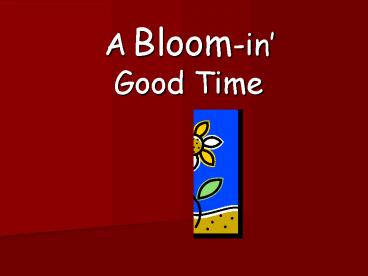Most technology lessons involve knowledge facts and compr PowerPoint PPT Presentation
1 / 10
Title: Most technology lessons involve knowledge facts and compr
1
A Bloom-inGood Time
2
Almost 50 years ago, Benjamin Bloom created a
list differentiating the levels of questioning in
education. Most technology lessons involve
knowledge (facts) and comprehension
(understanding). Technology, however, lends
itself to all levels of thinking. This Techtorial
provides tips for successfully incorporating all
levels of questioning into your technology
lessons.
3
Knowledge Comprehension Application
Analysis Synthesis
Evaluation
4
Knowledge What do you know about __________?
Comprehension What do you understand about
____________?
Application How can you use what you know about
_________ in another situation or with another
topic?
AnalysisWhat similarities, problems, parts,
trends, etc. do you see in _________?
Synthesis Can you combine _________ and
_________ to develop a new idea?
Evaluation How do you assess ____________ based
upon specified criteria?
5
KNOWLEDGE(Know it!) Make sure the facts are
correct and relevant for the age, the grade, and
the scope of the unit. Instead of using a more
general search engine, try the Internet Public
Library or KidsClick for more focused and
grade-appropriate searches. Dont allow students
to print entire Web pages instead have them
rewrite facts in their own words.
6
COMPREHENSION(Get it!) Assess primary students'
understanding of a topic by encouraging them to
use flashcards or to play matching games at
FunBrain or Quia. Have K-8 students read books
and then answer questions about those books at
BooksAdventure!
7
APPLICATION(Use it!) Ask students to voice
their choice by answering a poll at the Time For
Kids PollZone. Invite students to go on a Web
Adventure , collect facts about a topic (such as
the opposing political sides of the American
Revolution, for example), and then choose a
position. Have students collect data on a simple
topic, such as How many pets do you have? Then
have them create charts of the data using the
NCES graphing page.
8
ANALYSIS(Take it apart!) Students identify a
topic, trend, or theme in history. They read and
listen to eyewitness accounts of a particular
historical era at Ibis or look at cultural
artifacts of that era at American Memory to find
the specified topic, trend, or theme. (For
example, students might look for xenophobia in
the literature and art of the 1920s.) ThinkTank
can help students analyze and subdivide research
topics for major projects.
9
SYNTHESIS(Put it together!) Have students in
grades 4-6 use Backflip to create folders
containing all the Web sites they have found on a
given topic. Students can research three to four
people from the same occupation at Biography
Channel. Then have them use some of the
characteristics identified in the biographies to
write a fake biography about a fictitious
person engaged in the same occupation.
10
EVALUATION(Examine it!) Have students review
novels and then submit their reviews to
KidsBookshelf. Students in grades 5-6 students
can create free surveys at Zoomerang, invite
their peers to answer the surveys, and evaluate
the results. Get students involved in the
learning process by having them help you create
checklists for evaluating problem-based learning
activities in the classroom.

